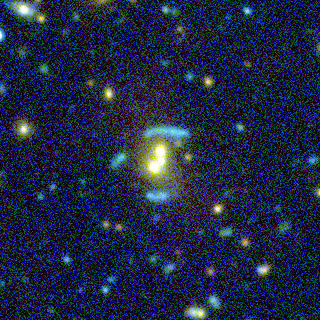Interesting things happen when gravitational lenses go to work. The earliest observations of the phenomenon involved entire clusters of galaxies. When the alignment is right, a galaxy cluster between the observer and a still more distant galaxy will bend the light of that galaxy. It will appear as one or more luminous arcs which are actually made up of its multiple images distorted (and magnified) by the gravitational lens.

All this happens because, as Einstein told us, spacetime is curved by the presence of matter. Here’s how gravitational lensing looks. Notice the blue arcs of the lensed galaxy in the background surrounding the galaxies at their center, which have distorted spacetime enough to make this image possible.
The latest work on the lensing phenomenon focuses on smaller structures like groups — rather than entire clusters — of galaxies. Astronomers using the Canada-France-Hawaii Telescope (Hawaii) are devoting 500 nights of telescope time to a survey of an area of the sky comparable to four full moons. The effort will be stretched over a five year period.
Image: This example of a galaxy group lens in the CFHTLS-SL2S, called SL2SJ021408-053532, shows a very complex arc structure (in blue). Such complex arc geometries allow us to probe the details of the dark matter profiles associated with the group of yellow galaxies in the center of the image. Credit: Canada-France-Hawaii Telescope Corporation 2006.
Lensing arcs around various groups of galaxies have begun showing up in the survey. They’re more than just intriguing visual objects. In fact, they provide an opportunity to study the distribution of dark matter in the galaxy groups in question, telling us much about mass we can see and mass that remains dark but provides its signature through the operation of curved spacetime. We’ve only been looking at gravitational lensing for twenty years now, but it’s clear these unusual displays are becoming prime tools for understanding the large scale structure of the cosmos.


http://www.nature.com/news/2007/070205/full/070205-8.html
The above article introduces the concept of “bottled light.” It seems a very deep aspect of physical law at work, and yet only now is it being empirically handled. When something this deeps gets uncovered, it seems like it might “be just around the corner” for us to understand dark matter and dark energy — and everything else for that matter.
Like Newton said, “The whole ocean of truth lays beyond.” The next beach pebble we attend to might be just the “bottled light” kind of concept we need to POP the truth about faster than light travel or how to pass Einstein’s speed limit without getting a traffic citation.
Edg
Ecg, that’s a fascinating paper, and I certainly share your enthusiasm! Thanks for the link.
Indeed we found strong lenses generated by galaxy group scale dark matter haloes. This was predicted theoretically since some time, but recently discovered thanks to the CFHTLS project.
The lens you see above have also been imaged from space using the Hubble Space Telescope, which resolution gives much better insights into the properties of the lensed features. I encourage the interested people to look at the space based image:
http://www.dark-cosmology.dk/~marceau/SL2S021408.jpg
and eventually have a look at the associated paper:
A new window of exploration in the mass spectrum: strong lensing by galaxy groups in the SL2S.
Limousin et al., 2009, A&A, 502, 445
http://www.dark-cosmology.dk/~marceau/groups_sl2s.pdf
We are currently investigating this system in more details by combining other measurements …
enjoy !
marceau